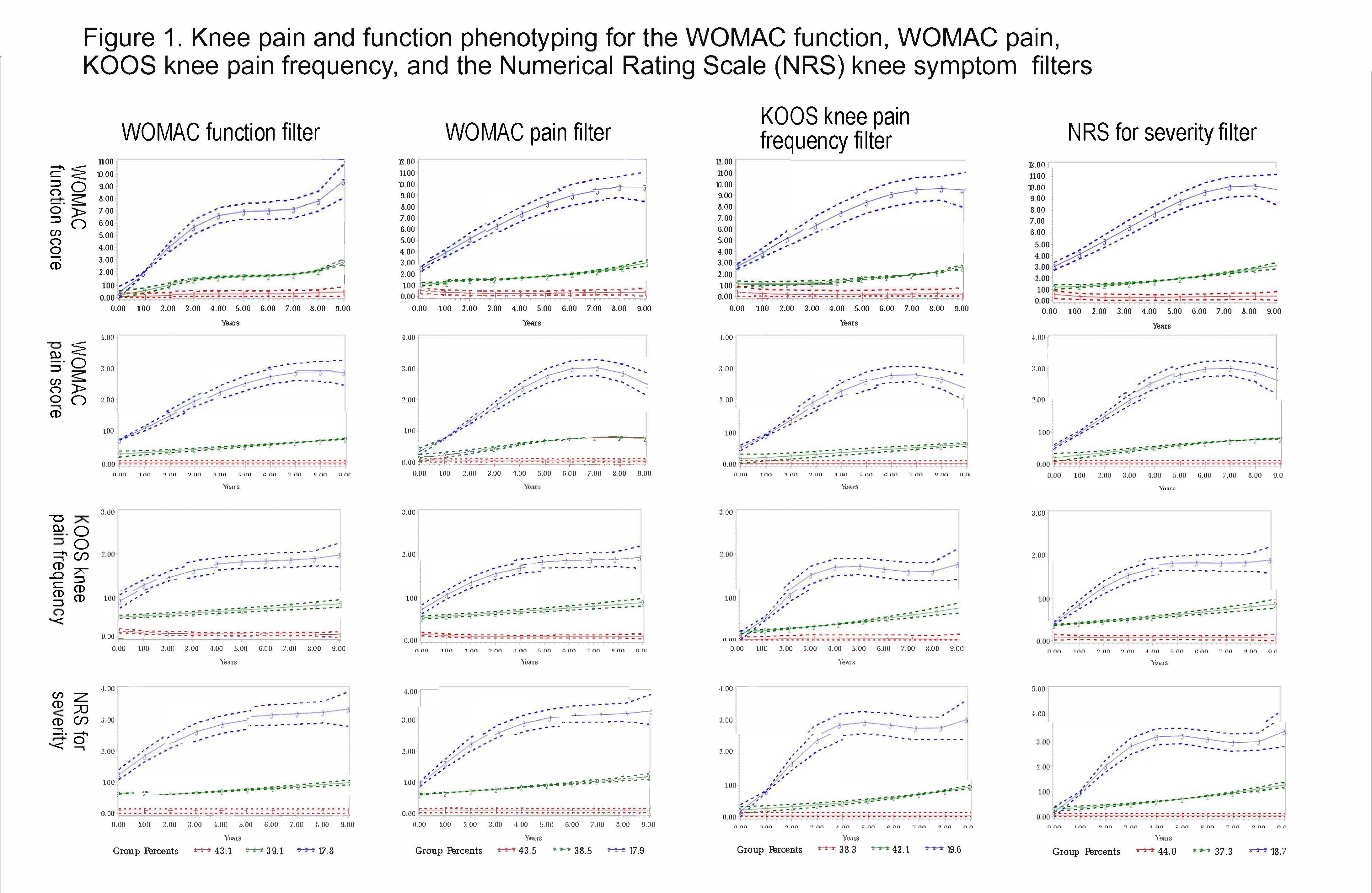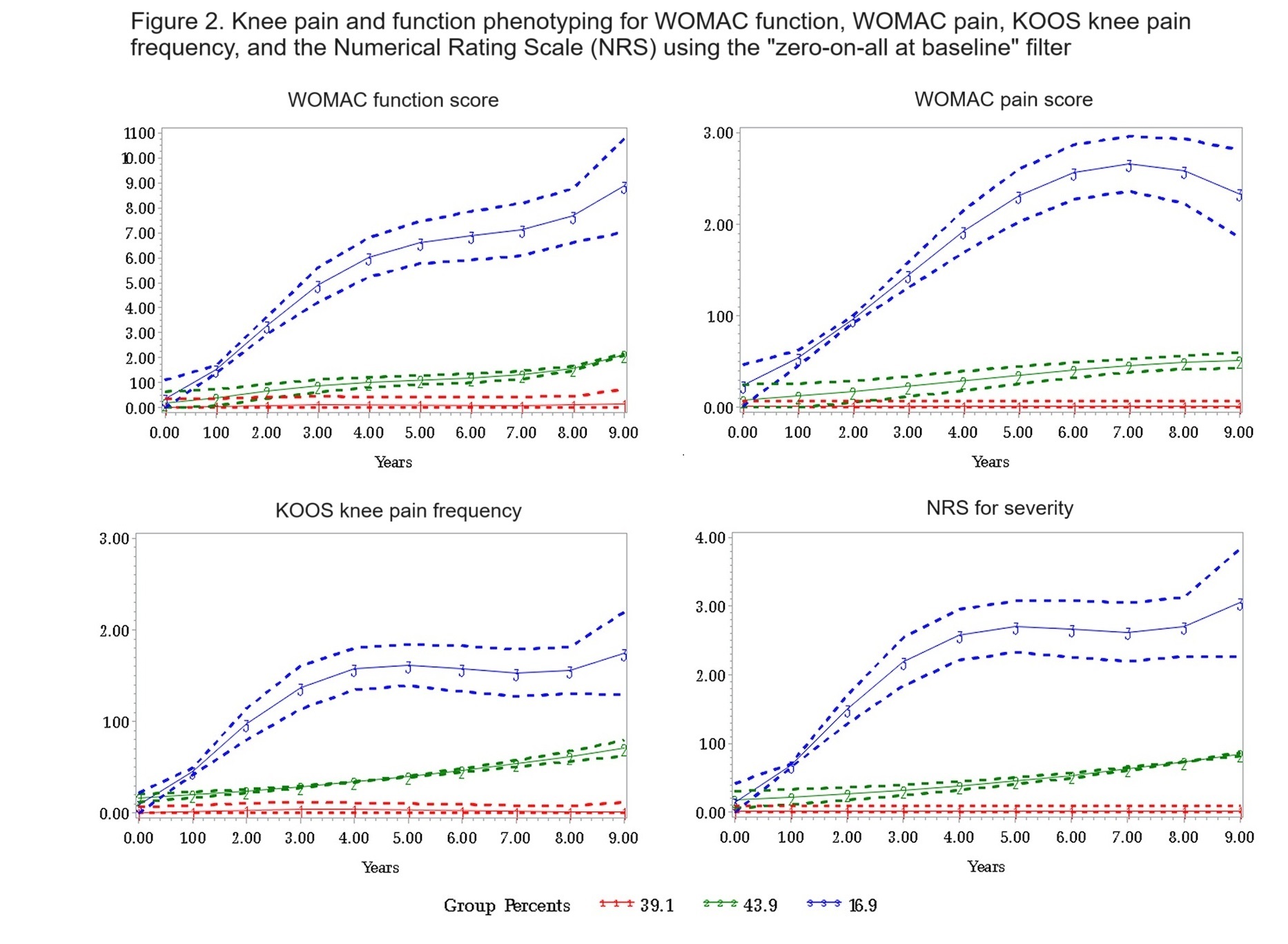Session Information
Session Type: Poster Session C
Session Time: 10:30AM-12:30PM
Background/Purpose: Knee pain is the most common presenting symptom of knee OA, and functional limitations are a common sequelae. Understanding the various patterns of pain and function changes over time can help identify individuals most in needed of targeted interventions. Prior studies have typically assessed only knee pain with a single, one-knee pain measure and have not incorporated function in a holistic approach to more comprehensively understanding symptom patterns. Our objective was to analyze knee symptoms (i.e., pain/function) data over 96 months among individuals with or at risk for knee OA from the OAI and identify representative temporal knee pain/function phenotypes based on four different knee pain/function measurements.
Methods: We used the following knee pain/function measures from each OAI time-point from baseline to month 96 to develop our knee symptom phenotypes: WOMAC function score (0-68, none to extreme functional limitation), WOMAC pain score (0-20, none to extreme pain), KOOS knee pain frequency (0-4, i.e., none, monthly, weekly, daily), and the Numerical Rating Scale (NRS) for knee pain severity (0-10, none to worst pain). To select the knees for inclusion, we separately identified knees with a score of 0 at baseline for each particular pain/function measure; these were each considered to be a ‘filter’. Within each set of selected knees based on an individual filter, we employed group-based multiple-trajectory modeling (GBMTM) to cluster the selected knees into distinct knee pain/function progression trajectories. In addition, we created a “zero-on-all at baseline” filter to select those knees that had a score of 0 for all four measures at baseline and applied GBMTM to this subset of knees.
Results: The numbers of selected knees by each measure that had a score of 0 at baseline were 2,156 for WOMAC function, 2,560 for WOMAC pain, 1,552 for KOOS knee pain frequency, 1,994 for NRS, and 1,136 for the “zero-on-all at baseline” filter. Three distinct clusters were generated by GBMTM with the knees selected by each of the four single measure-based selection criteria (Figure 1). For example, for the WOMAC function set, the knees in the blue cluster accounted for 17.8% of the selected knees with a score of 0 at baseline. This cluster showed rapid progression over follow-up across all four measures. In contrast, the knees in the green (39.1%) cluster demonstrated slow progression, and knees in the red (43.1%) cluster demonstrated very little progression. Similar patterns can be observed when the other three filters were applied. Figure 2 illustrates the results of the knees selected with the “zero-on-all at baseline” filter. The progression patterns for the three clusters were similar to those shown in Figure 1.
Conclusion: Based on four pain/function measures in OAI, we identified three distinct temporal phenotypes of knee pain/function progression patterns, which resulted in similar trajectories regardless of the pain/function measure. These patterns were similar for each of the four pain/function study samples and the “zero-on-all at baseline” sample. The cluster with rapid symptom progression may represent a group to target with interventions earlier in their disease course.
To cite this abstract in AMA style:
Ge Y, Doung T, Liu S, Sun X, Neogi T, Nelson A, Duryea J, Kwoh K. Knee Symptom Phenotyping Incorporating Pain and Function: A Multiple-Trajectory Modeling-Based Study Using Data from the Osteoarthritis Initiative (OAI) [abstract]. Arthritis Rheumatol. 2024; 76 (suppl 9). https://acrabstracts.org/abstract/knee-symptom-phenotyping-incorporating-pain-and-function-a-multiple-trajectory-modeling-based-study-using-data-from-the-osteoarthritis-initiative-oai/. Accessed .« Back to ACR Convergence 2024
ACR Meeting Abstracts - https://acrabstracts.org/abstract/knee-symptom-phenotyping-incorporating-pain-and-function-a-multiple-trajectory-modeling-based-study-using-data-from-the-osteoarthritis-initiative-oai/


